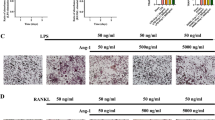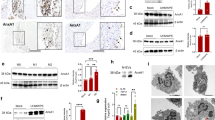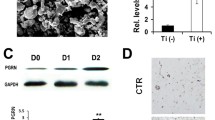Abstract
Wear particle-induced vascularized granulomatous inflammation and subsequent inflammatory osteolysis is the most common cause of aseptic loosening after total joint replacement (TJR); however, the precise mechanism by which this occurs is unclear. This study investigates the effects of the proteasome inhibitor bortezomib (Bzb) on the expression of key biochemical markers of bone metabolism and vascularised granulomatous tissues, such as receptor activator of nuclear factor-κB ligand (RANKL), osteoprotegerin (OPG), vascular endothelial growth factor (VEGF) and tumor necrosis factor receptor-associated factor 6 (TRAF6). In addition, the effect of Bzb on apoptosis of CD68+ cells was examined. A total of 32 female BALB/C mice were randomly divided into four groups. After implantation of calvaria bone from syngeneic littermates, titanium (Ti) particles were injected into established air pouches for all mice (excluding negative controls) to provoke inflammatory osteolysis. Subsequently, Bzb was administered at a ratio of 0, 0.1, or 0.5 mg/kg on day 1, 4, 8, and 11 post-surgery to alleviate this response. All of the air pouches were harvested 14 days after the surgical procedure and were processed for molecular and histological analysis. The results demonstrated that Ti injection elevated the expression of RANKL, OPG, VEGF, and TRAF6 at both the gene and protein levels, increased counts of infiltrated cells and thickness of air pouch membranes, and elevated the apoptosis index (AI) of CD68+ cells. Bzb treatment significantly improved Ti particle-induced implanted bone osteolysis, attenuated vascularised granulomatous tissues and elevated AI of CD68+ cells. Therefore, the proteasome pathway may represent an effective therapeutic target for the prevention and treatment of aseptic loosening.








Similar content being viewed by others
References
Ingham, E., and J. Fisher. 2005. The role of macrophages in osteolysis of total joint replacement. Biomaterials 26(11): 1271–1286.
Wang, M., P. Sharkey, and R. Tuan. 2004. Particle bioreactivity and wear-mediated osteolysis. The Journal of Arthroplasty 19(8): 1028–1038.
Ren, W.P., D.C. Markel, R. Zhang, X. Peng, B. Wu, H. Monica, and P.H. Wooley. 2006. Association between UHMWPE particle-induced inflammatory osteoclastogenesis and expression of RANKL, VEGF, and Flt-1 in vivo. Biomaterials 27(30): 5161–5169.
Al-Saffar, N., J. Mah, Y. Kadoya, and P.A. Revell. 1995. Neovascularisation and the induction of cell adhesion molecules in response to degradation products from orthopaedic implants. Annals of the Rheumatic Diseases 54(3): 201–208.
Ren, W., R. Zhang, D.C. Markel, B. Wu, X. Peng, M. Hawkins, and P.H. Wooley. 2007. Blockade of vascular endothelial growth factor activity suppresses wear debris-induced inflammatory osteolysis. Journal of Rheumatology 34(1): 27–35.
Markel, D.C., R. Zhang, T. Shi, M. Hawkins, and W. Ren. 2009. Inhibitory effects of erythromycin on wear debris-induced VEGF/Flt-1 gene production and osteolysis. Inflammation Research 58(7): 413–421.
Zhang, W., Peng, X., Cheng, T., and Zhang, X. 2011. Vascular endothelial growth factor gene silencing suppresses wear debris-induced inflammation. Int Orthop. Available from URL: http://www.springerlink.com/content/86m1431q8035755q/ (doi:10.1007/s00264-011-1252-4).
Anandarajah, A.P. 2009. Role of RANKL in bone diseases. Trends in Endocrinology and Metabolism 20(2): 88–94.
Bord, S., D. Ireland, S. Beavan, and J. Compston. 2003. The effects of estrogen on osteoprotegerin, RANKL, and estrogen receptor expression in human osteoblasts. Bone 32(2): 136–141.
Ye, H., J.R. Arron, B. Lamothe, M. Cirilli, T. Kobayashi, N.K. Shevde, D. Segal, O.K. Dzivenu, M. Vologodskaia, and M. Yim. 2002. Distinct molecular mechanism for initiating TRAF6 signalling. Nature 418(6896): 443–447.
Armstrong, A.P., M.E. Tometsko, M. Glaccum, C.L. Sutherland, D. Cosman, and W.C. Dougall. 2002. A RANK/TRAF6-dependent signal transduction pathway is essential for osteoclast cytoskeletal organization and resorptive function. Journal of Biological Chemistry 277(46): 44347–44356.
Boyle, W.J., W.S. Simonet, and D.L. Lacey. 2003. Osteoclast differentiation and activation. Nature 423(6937): 337–342.
Kobayashi, N., Y. Kadono, A. Naito, K. Matsumoto, T. Yamamoto, S. Tanaka, and J. Inoue. 2001. Segregation of TRAF6-mediated signaling pathways clarifies its role in osteoclastogenesis. EMBO Journal 20(6): 1271–1280.
Elliott, P.J., and J.S. Ross. 2001. The proteasome. American Journal of Clinical Pathology 116(5): 637–646.
Wickner, S., M.R. Maurizi, and S. Gottesman. 1999. Posttranslational quality control: folding, refolding, and degrading proteins. Science 286(5446): 1888–1893.
Richardson, P.G., B. Barlogie, J. Berenson, S. Singhal, S. Jagannath, D. Irwin, S.V. Rajkumar, G. Srkalovic, M. Alsina, and R. Alexanian. 2003. A phase 2 study of bortezomib in relapsed, refractory myeloma. The New England Journal of Medicine 348(26): 2609–2617.
von Metzler, I., H. Krebbel, M. Hecht, R.A. Manz, C. Fleissner, M. Mieth, M. Kaiser, C. Jakob, J. Sterz, L. Kleeberg, U. Heider, and O. Sezer. 2007. Bortezomib inhibits human osteoclastogenesis. Leukemia 21(9): 2025–2034.
Heider, U., M. Kaiser, C. Müller, C. Jakob, I. Zavrski, C.O. Schulz, C. Fleissner, M. Hecht, and O. Sezer. 2006. Bortezomib increases osteoblast activity in myeloma patients irrespective of response to treatment. European Journal of Haematology 77(3): 233–238.
Arpinati, M., G. Chirumbolo, B. Nicolini, C. Agostinelli, and D. Rondelli. 2008. Selective apoptosis of monocytes and monocyte-derived DCs induced by bortezomib (Velcade). Bone Marrow Transplantation 43(3): 253–259.
Rakshit, D.S., K. Ly, T.K. Sengupta, B.J. Nestor, T.P. Sculco, L.B. Ivashkiv, and P.E. Purdue. 2006. Wear debris inhibition of anti-osteoclastogenic signaling by interleukin-6 and interferon- gamma mechanistic insights and implications for periprosthetic osteolysis. The Journal of Bone and Joint Surgery American 88(4): 788–799.
Wooley, P.H., R. Morren, J. Andary, S. Sud, S.Y. Yang, L. Mayton, D. Markel, A. Sieving, and S. Nasser. 2002. Inflammatory responses to orthopaedic biomaterials in the murine air pouch. Biomaterials 23(2): 517–526.
Livak, K.J., and T.D. Schmittgen. 2001. Analysis of relative gene expression data using real-time quantitative PCR and the 2-ΔΔCT method. Methods 25(4): 402–408.
Ren, W., D.C. Markel, R. Schwendener, Y. Ding, B. Wu, and P.H. Wooley. 2008. Macrophage depletion diminishes implant-wear-induced inflammatory osteolysis in a mouse model. Journal of Biomedical Materials Research. Part A 85(4): 1043–1051.
Purdue, P.E., P. Koulouvaris, B.J. Nestor, and T.P. Sculco. 2006. The central role of wear debris in periprosthetic osteolysis. HSS Journal 2(2): 102–113.
Goodman, S.B., M. Trindade, T. Ma, M. Genovese, and R.L. Smith. 2005. Pharmacologic modulation of periprosthetic osteolysis. Clinical Orthopaedics and Related Research 430: 39–45.
Ren, W., X.H. Li, B.D. Chen, and P.H. Wooley. 2004. Erythromycin inhibits wear debris-induced osteoclastogenesis by modulation of murine macrophage NF-κB activity. Journal of Orthopaedic Research 22(1): 21–29.
Miyanishi, K., M.C.D. Trindade, T. Ma, S.B. Goodman, D.J. Schurman, and R.L. Smith. 2003. Periprosthetic osteolysis: induction of vascular endothelial growth factor from human monocyte/macrophages by orthopaedic biomaterial particles. Journal of Bone and Mineral Research 18(9): 1573–1583.
Senger, D.R., S.J. Galli, A.M. Dvorak, C.A. Perruzzi, V.S. Harvey, and H.F. Dvorak. 1983. Tumor cells secrete a vascular permeability factor that promotes accumulation of ascites fluid. Science 219(4587): 983–985.
Ferrara, N., and W.J. Henzel. 1989. Pituitary follicular cells secrete a novel heparin-binding growth factor specific for vascular endothelial cells. Biochemical and Biophysical Research Communications 161(2): 851–858.
Leung, D.W., G. Cachianes, W.J. Kuang, D.V. Goeddel, and N. Ferrara. 1989. Vascular endothelial growth factor is a secreted angiogenic mitogen. Science 246(4935): 1306–1309.
Min, J., Y. Kim, E. Kim, Y. Gho, I. Kang, S. Lee, Y. Kong, and Y. Kwon. 2003. Vascular endothelial growth factor up-regulates expression of receptor activator of NF-kappa B (RANK) in endothelial cells. Concomitant increase of angiogenic responses to RANK ligand. Journal of Biological Chemistry 278(41): 39548–39557.
Wong, B., R. Josien, S. Lee, B. Sauter, H. Li, R. Steinman, and Y. Choi. 1997. TRANCE (tumor necrosis factor [TNF]-related activation-induced cytokine), a new TNF family member predominantly expressed in T cells, is a dendritic cell-specific survival factor. The Journal of Experimental Medicine 186(12): 2075–2080.
Leibbrandt, A., and J.M. Penninger. 2008. RANK/RANKL: regulators of immune responses and bone physiology. Annals of the New York Academy of Sciences 1143(1): 123–150.
Mandelin, J., T.F. Li, M. Liljestrom, M. Kroon, R. Hanemaaijer, S. Santavirta, and Y.T. Konttinen. 2003. Imbalance of RANKL/RANK/OPG system in interface tissue in loosening of total hip replacement. The Journal of Bone and Joint Surgery British 85(8): 1196–1201.
Haynes, D.R., T. Crotti, A. Potter, M. Loric, G.J. Atkins, D.W. Howie, and D.M. Findlay. 2001. The osteoclastogenic molecules RANKL and RANK are associated with periprosthetic osteolysis. The Journal of Bone and Joint Surgery. British Volume 83(6): 902–911.
Ren, W., R. Blasier, X. Peng, T. Shi, P.H. Wooley, and D. Markel. 2009. Effect of oral erythromycin therapy in patients with aseptic loosening of joint prostheses. Bone 44(4): 671–677.
Bylski, D., C. Wedemeyer, J. Xu, T. Sterner, F. Löer, and M. von Knoch. 2009. Alumina ceramic particles, in comparison with titanium particles, hardly affect the expression of RANK-, TNF-α-, and OPG-mRNA in the THP-1 human monocytic cell line. Journal of Biomedical Materials Research. Part A 89(3): 707–716.
Granchi, D., G. Ciapetti, I. Amato, S. Pagani, E. Cenni, L. Savarino, S. Avnet, J. Peris, A. Pellacani, and N. Baldini. 2004. The influence of alumina and ultra-high molecular weight polyethylene particles on osteoblast–osteoclast cooperation. Biomaterials 25(18): 4037–4045.
Baumann, B., C. Rader, J. Seufert, U. Nöth, O. Rolf, J. Eulert, and F. Jakob. 2004. Effects of polyethylene and TiAIV wear particles on expression of RANK, RANKL and OPG mRNA. Acta Orthopaedica 75(3): 295–302.
Masui, T., S. Sakano, Y. Hasegawa, H. Warashina, and N. Ishiguro. 2005. Expression of inflammatory cytokines, RANKL and OPG induced by titanium, cobalt-chromium and polyethylene particles. Biomaterials 26(14): 1695–1702.
Inoue, J., T. Ishida, N. Tsukamoto, N. Kobayashi, A. Naito, S. Azuma, and T. Yamamoto. 2000. Tumor necrosis factor receptor-associated factor (TRAF) family: adapter proteins that mediate cytokine signaling. Experimental Cell Research 254(1): 14.
Rauner, M., W. Sipos, and P. Pietschmann. 2006. Osteoimmunology. International Archives of Allergy and Immunology 143(1): 31–48.
Hongming, H., and H. Jian. 2009. Bortezomib inhibits maturation and function of osteoclasts from PBMCs of patients with multiple myeloma by downregulating TRAF6. Leukemia Research 33(1): 115–122.
Ang, E., N.J. Pavlos, S.L. Rea, M. Qi, T. Chai, J.P. Walsh, T. Ratajczak, M.H. Zheng, and J. Xu. 2009. Proteasome inhibitors impair RANKL-induced NF-κB activity in osteoclast-like cells via disruption of p62, TRAF6, CYLD, and IκBα signaling cascades. Journal of Cellular Physiology 220(2): 450–459.
Baldwin, L., B. Flanagan, P. McLaughlin, R. Parkinson, J. Hunt, and D. Williams. 2002. A study of tissue interface membranes from revision accord knee arthroplasty: the role of T lymphocytes. Biomaterials 23(14): 3007–3014.
Micklem, K., E. Rigney, J. Cordell, D. Simmons, P. Stross, H. Turley, B. Seed, and D. Mason. 1989. A human macrophage-associated antigen (CD68) detected by six different monoclonal antibodies. British Journal of Haematology 73(1): 6–11.
Anan, A., E.S. Baskin-Bey, H. Isomoto, J.L. Mott, S.F. Bronk, J.H. Albrecht, and G.J. Gores. 2006. Proteasome inhibition attenuates hepatic injury in the bile duct-ligated mouse. American Journal of Physiology - Gastrointestinal and Liver Physiology 291(4): G709–G716.
Pagliari, L.J., H. Perlman, H. Liu, and R.M. Pope. 2000. Macrophages require constitutive NF-kappa B activation to maintain A1 expression and mitochondrial homeostasis. Molecular and Cellular Biology 20(23): 8855–8865.
Landgraeber, S., M. von Knoch, F. Loer, A. Wegner, M. Tsokos, and M. Totsch. 2008. Extrinsic and intrinsic pathways of apoptosis in aseptic loosening after total hip replacement. Biomaterials 29(24–25): 3444–3450.
Mao, X., Pan, X., Cheng, T., and Zhang, X. 2011. Therapeutic potential of the proteasome inhibitor bortezomib on titanium particle-induced inflammation in a murine model. Inflammation. Available from URL: http://www.springerlink.com/content/u5516224u6501835/ (doi:10.1007/s10753-011-9392-7).
Jimi, E., K. Aoki, H. Saito, F. D'Acquisto, M.J. May, I. Nakamura, T. Sudo, T. Kojima, F. Okamoto, and H. Fukushima. 2004. Selective inhibition of NF-kappaB blocks osteoclastogenesis and prevents inflammatory bone destruction in vivo. Nature Medicine 10(6): 617–624.
Hofbauer, L., D. Lacey, C. Dunstan, T. Spelsberg, B. Riggs, and S. Khosla. 1999. Interleukin-1 [beta] and tumor necrosis factor-[alpha], but not interleukin-6, stimulate osteoprotegerin ligand gene expression in human osteoblastic cells. Bone 25(3): 255–259.
Acknowledgments
This work was supported by the Integration of Medicine and Engineering Foundation of Shanghai Jiaotong University (YG2010MS33).
Author information
Authors and Affiliations
Corresponding author
Rights and permissions
About this article
Cite this article
Mao, X., Pan, X., Zhao, S. et al. Protection Against Titanium Particle-Induced Inflammatory Osteolysis by the Proteasome Inhibitor Bortezomib In Vivo . Inflammation 35, 1378–1391 (2012). https://doi.org/10.1007/s10753-012-9451-8
Published:
Issue Date:
DOI: https://doi.org/10.1007/s10753-012-9451-8




